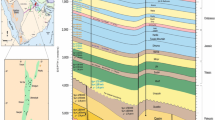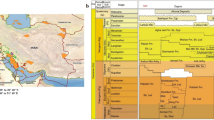Abstract
The excessive burning of the fossil fuels has caused severe global climatic changes such as increasing the global temperature, causing initiation of the wild fire, rising the sea level, increasing the floods, storms, amount of rain and snow. One of the effective global mitigation strategies is sequestration of huge quantity of CO2 deep below the ground level for a long period of time. An important issue is to ensure the permanency and safety of the sequestration process due to the associated pore-pressure buildup. It is necessary to have correct estimates of the pore-pressure buildup, ground uplift and re-activation of any existing fault during the process of CO2 injection and long-term storage. In this investigation, the effects of reservoir size and boundary conditions are investigated by means of geomechanical modeling of the deep Biyadh sandstone reservoir in Saudi Arabia. Currently, carbon dioxide is not injected into the actual Biyadh reservoir. In this investigative modeling, CO2 is injected for an injection period of ten years using a single injection well at the center of the reservoir. The developed modeling scheme for a single injection well has been extended further to include multiple injection wells. For multiple injection wells, the reservoir size and locations of injection wells are varied to evaluate their effect on the pore-pressure buildup and ground uplift. The reservoir stability analysis has been performed using Mohr–Coulomb failure criterion for both small and large reservoir models, with the same injection parameters. The simulation results demonstrated that pressure buildup and ground uplift are relatively higher for reservoirs with small sizes and closed boundaries; while in the case of large sizes and open boundaries, the pore-pressure buildup and ground uplift are relatively lower. Moreover, the effect of the reservoir size and boundary conditions on the reactivation of faults during CO2 injection has been evaluated. The stability analysis performed in this study shows that injecting CO2 into larger size reservoir is safer as compared to smaller size reservoir. Injecting CO2 with multiple injection wells will cause pore-pressure buildup of huge magnitudes. The modeling results show that suggesting a representative volume for the reservoir during CO2 injection can under-estimate the pore-pressure buildup and fault re-activation that can cause the reservoir failure and leakage of the stored CO2.

























Similar content being viewed by others
Abbreviations
- \(C\) :
-
Elastic tensor
- \(F_{{\text{v}}}\) :
-
Volume force vector (N/m3)
- \(p_{{\text{f}}}\) :
-
Pore pressure (Pa)
- \(Q_{{\text{m}}}\) :
-
Source term (kg/m3)
- \(q\) :
-
Darcy’s velocity vector (m/sec2)
- u :
-
Displacement components (m)
- α:
-
Biot’s coefficient
- ϕ :
-
Matrix Porosity
- \(\varepsilon\) :
-
Strain tensor
- \(\rho\) :
-
Density (kg/m3)
- \(\sigma\) :
-
Stress tensor (N/m2)
References
Abdulkader MA (2005) Ghawar: The anatomy of the world's largest oil field. Saudi Aramco search and discovery article#20026. https://www.searchanddiscovery.com/documents/2004/afifi01/. Accessed 21 Apr 2019
Al-Husseini MI (1997) Jurassic sequence stratigraphy of the Western and Southern Arabian Gulf. GeoArabia 2(4):361–382
Al-Shuhail AA, Alshuhail AA, Khulief YA (2014) CO2 leakage detection using geophysical methods under arid near-surface conditions: progress report of KACST TIC-CCS project number TIC-CCS-1, Saudi Arabia
Al-Shuhail AA, Alshuhail AA, Khulief YA et al (2019) KFUPM Ghawar digital viscoelastic seismic model. Arab J Geosci 12:245. https://doi.org/10.1007/s12517-019-4390-4
Ameen MS et al (2009) Predicting rock mechanical properties of carbonates from wireline logs (A case study: Arab- D reservoir, Ghawar field, Saudi Arabia). Mar Pet Geol 26:430–444
Amirlatifi A (2013) Coupled Geomechanical Reservoir Simulation. Dissertation, Missouri University of Science and Technology
Anjani K, Varun P (1998) The role of coupled geomechanical modeling in reservoir simulation Calgary, Alberta. https://www.cmgl.ca/events/webinar-coupled-geomechanics. Accessed 21 Apr 2019
Ashkan B et al (2013) Simulation study of CO2 sequestration potential of the Mary Lee coal zone, Black Warrior basin. Environ Earth Sci 70:2501–2509
Baklid A, Korbol R, Owren G (1996) Sleipner Vest CO2 Disposal, CO2 injection into a shallow underground aquifer. Soc Petrol Engineers. https://doi.org/10.2118/36600-MS
Bert M et al (2005) IPCC special report on carbon dioxide capture and storage. Cambridge University Press, Cambridge
Bruant RGJ et al (2002) Safe storage of CO2 in deep saline aquifers. Environ Sci Technol 36:240–245
CMG-GEM [Computer software] (2010) Computer Modelling Group, Calgary, Alberta, Canada
COMSOL [Computer software] (2016) COMSOL Inc., Burlington, MA
Cristina R, Maria AD, Manuel JL (2013) Unconventional coal reservoir for CO2 safe geological sequestration. Int J Glob Warm 5(1):46–66
Eshiet K, Sheng Y (2014) Investigation of geomechanical responses of reservoirs induced by CO2 storage. Environ Earth Sci 71:3999–4020
Gameil M, Abdelbaset S (2015) Gastropods from the Campanian Maastrichtian Aruma formation, Central Saudi Arabia. J Afr Earth Sci 103:128–139
Godec M, Koperna G, Petrusak R, Oudinot A (2013) Assessment of factors influencing CO2 storage capacity and injectivity in Eastern US. Gas Shale Energy Proc 37:6644–6655
Guo C, Wei M, Chen H, Xiaoming H, Bai B (2014) Improved Numerical Simulation for Shale Gas Reservoirs. In: Proc., Offshore Technology Conf.-Asia, OTC-24913, Offshore Technology Conference, Kuala Lumpur, Malaysia, pp 1–17
Gunter WD, Mavor MJ, Robinson JR (2004) CO2 storage and enhanced methane production: field testing at Fenn-Big Valley, Alberta, Canada, with application. In: Proceedings of the 7th International Conference on Greenhouse Gas Control Technologies (GHGT-7), Alberta, Canada, pp 413–422
Han WS, Kim KY (2018) Evaluation of CO2 plume migration and storage under dip and sinusoidal structures in geologic formation. J Petrol Sci Eng 169(1):760–771
Hakimi MH, Shalaby MR, Abdullah WH (2012) Diagenetic characteristics and reservoir quality of the lower cretaceous Biyadh sandstones at Kharir oilfield in the western central Masila basin, Yemen. J Asian Earth Sci 51:109–120
Heidbach O et al (2009) The World Stress Map based on the database release 2008, Equatorial scale 1:46,000,000, Commission for the Geological Map of the World, Paris. https://publikationen.bibliothek.kit.edu/1000028970. Accessed 7 June 2020
Holzbecher E (2013) Poroelasticity benchmarking for FEM on Analytical Solutions. In: Proceedings of the COMSOL Conference, Rotterdam, pp 1–7
IPCC (2014) Climate Change 2014. Observed changes and their causes. Intergovernmental panel on climate Change. https://ar5-syr.ipcc.ch/topic_observedchanges.php. Accessed 7 June 2020
Jtirgen ES, Siggins FA, Brian JE (2005) Predicting and monitoring geomechanical effects of CO2 injection. Carbon dioxide Capture Storage Deep Geol Format 2:751–766
Khan S, Al-Shuhail AA, Khulief YA (2016) Numerical modeling of the geomechanical Behavior of Ghawar Arab-D carbonate petroleum reservoir undergoing CO2 injection. Environ Earth Sci J 75:1. https://doi.org/10.1007/s12665-016-6122-3
Khan S, Khulief YA, Al-Shuhail AA (2017) Numerical modeling of the Geomechanical behavior of Biyadh reservoir undergoing CO2 Injection. Int J Geomech 17(8):1–12. https://doi.org/10.1061/(ASCE)GM.1943-5622.0000893
Kharaka YK et al (2006) Gas-water-rock interactions in sedimentary basins: CO2 sequestration in the Frio Formation, Texas, USA. J Geochem Explor 89:183–186
Kiyama T et al (2011) Coal swelling strain and permeability change with injecting liquid/supercritical CO2 and N2 at stress-constrained conditions. Int J Coal Geol 85(1):56–64
Martin AZ (2001) Late Permian to Holocene Paleofacies evolution of the Arabian plate and its hydrocarbon occurrences. GeoArabia 6:445–504
Metz B, Davidson O, de Coninck H, Loos M, Meyer L (2007) A report on the mitigation of climate change. Cambridge University Press, Cambridge
Moeck I, Kwiatek G, Zimmermann G (2009) Slip tendency analysis, fault reactivation potential and induced seismicity in a deep geothermal reservoir. J Struct Geol 10:1174–1182
Pruess K, Nordbotten J (2011) Numerical simulation studies of the long-term evolution of a CO2 plume in a saline aquifer with a sloping caprock. Transp Porous Media 90(1):135–151
Qu HY, Liu JS, Pan ZJ, Connell L (2010) Impact of thermal processes on CO2 injectivity into a coal seam. IOP Conf Ser Mater Sci Eng. https://doi.org/10.1088/1757-899X/10/1/012090
Robert B et al (2007) Regional depositional history, stratigraphy and Palaeo geography of the Shuaiba. GeoArabia 12:135–152
Rutqvist J, Birkholzer JT, Cappa F, Tsang C (2007) Estimating maximum sustainable injection pressure during geological sequestration of CO2 using coupled fluid flow and geomechanical fault-slip analysis. Energy Convers Manage 48:1798–1807
Rutqvist J, Rinaldi AP, Cappa F, Moridis GJ (2013) Modeling of fault reactivation and induced seismicity during hydraulic fracturing of shale-gas reservoirs. J Petrol Sci Eng 107:31–44
Rutqvist J, Vasco DW, Myer L (2010) Coupled reservoir geomechanical analysis of CO2 injection and ground deformations at In Salah, Algeria. Int J Greenhouse Gas Control 4:225–230
Sams W, Grant B, Sinisha J, Turgay E, Duane HS (2005) “Field-project designs for carbon dioxide sequestration and enhanced coal bed methane production. Energy Fuels 19:2287–2297
Streit JE, Hillis RR (2004) Estimating fault stability and sustainable fluid pressures for underground storage of CO2 in porous rock. Energy 29:1445–1456
Sung SP et al (2016) Numerical modeling of the tensile fracture reactivation under the effects of rock geomechanical properties and heterogeneity during CO2 storage. Environ Earth Sci 75:298–303
Tan X, Heinz K (2014) Numerical study of variation in Biot's coefficient with respect to microstructure of rocks. Tectono-physics 61:159–171
Tao Q (2010) Numerical modeling of fracture permeability change in naturally fractured reservoirs using a fully coupled displacement discontinuity method. Dissertation, Texas A&M University
Teletzke GF, Lu P (2013) Guidelines for reservoir modeling of geologic CO2 storage. Energy Procedia 37:3936–3944
Tore B, Eyvind A, Elin S (2009) Safe storage parameters during CO2 injection using coupled reservoir geomechanical analysis. In: Excerpt from the Proceedings of the COMSOL Conference Milan
Torp TA, Gale J (2004) Demonstrating storage of CO2 in geological reservoirs: the Sleipner and SACS projects. Energy 29(9):1361–1369
Torvanger AK, Rypdal S (2005) Geological CO2 storage as a climate change mitigation option. Mitig Adapt Strat Glob Change 10(4):693–715
Wang et al (2016) Impacts of stratum dip angle on CO2 geological storage amount and security. Greenhouse Gas Sci Technol 6(1):682–694
Warren JE, Root PJ (1963) The behavior of naturally fractured reservoirs. Soc Petrol Engineers 3:245–255
White D (2009) Monitoring CO2 storage during EOR at the Weyburn-Midale field. Lead Edge 28:838–842
Wu Y, Liu J, Elsworth D (2010) Dual poroelastic response of a coal seam to CO2 injection. Int J Greenhouse Gas Control 4:668–678
Xiping W, Hongdou Z (2018) Valuation of CCS investment in China’s coal-fired power plants based on a compound real options model. Greenhouse Gas Sci Technol. https://doi.org/10.1002/ghg.1809
Zhou F, Hou W, Allinson G, Wu J, Wang J, Cinar Y (2013) A feasibility study of ECBM recovery and CO2 storage for a producing CBM field in Southeast Qinshui Basin, China. Int J Greenhouse Gas Control. https://doi.org/10.1016/j.ijggc.2013.08.011
Zhang H, Liu J, Elsworth D (2008) How sorption-induced matrix deformation affects gas flow in Coal seams: a new FE model. Int J Rock Mech Min Sci 45(8):1226–1236
Zhang L, Dilmore RM, Bromhal GS (2016) Effect of outer boundary condition, reservoir size, and CO2 effective permeability on pressure and CO2 saturation predictions under carbon sequestration conditions. Greenhouse Gas Sci Technol 6(4):546–560
Acknowledgements
This research work was funded by the National Plan for Science, Technology and Innovation (MAARIFAH)—King Abdul-Aziz City for Science and Technology—through the Science & Technology Unit at King Fahd University of Petroleum & Minerals (KFUPM)—the Kingdom of Saudi Arabia, award number (TIC-CCS-1).
Author information
Authors and Affiliations
Corresponding author
Additional information
Publisher's Note
Springer Nature remains neutral with regard to jurisdictional claims in published maps and institutional affiliations.
Rights and permissions
About this article
Cite this article
Khan, S., Khulief, Y.A. & Al-Shuhail, A.A. Effects of reservoir size and boundary conditions on pore-pressure buildup and fault reactivation during CO2 injection in deep geological reservoirs. Environ Earth Sci 79, 294 (2020). https://doi.org/10.1007/s12665-020-09040-0
Received:
Accepted:
Published:
DOI: https://doi.org/10.1007/s12665-020-09040-0




